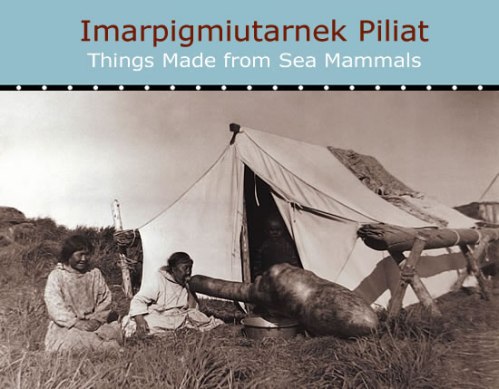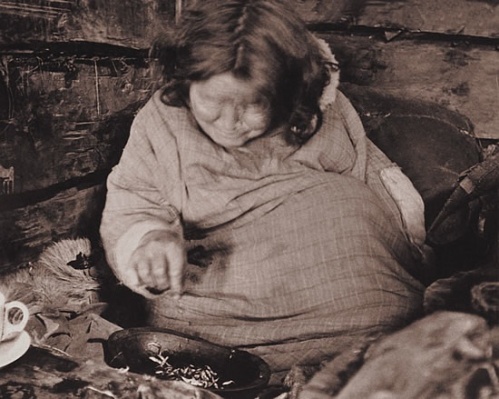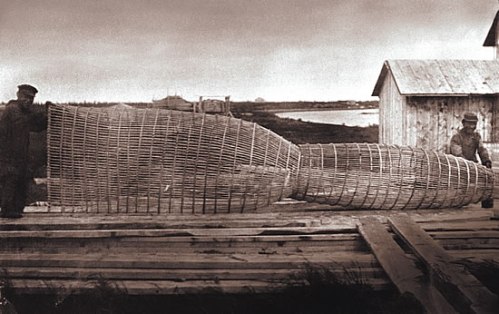“Yuungnaqpiallerput (The Way We Genuinely Live): Masterworks of Yup’ik Science and Survival” is a fascinating and informative (and large!) website companion to a 2008 exhibition by the same name at the Anchorage Museum. Books and catalogues are also available and look to be excellent.
I know that Yup’ik territory, on the southern flanks of the Bering Straits, is a long way from the Northwest Coast. But there are many similarities in the ingenious tricks and tools of the trade needed for a maritime lifestyle, and this exhibition deftly combines historical, archaeological and ethnographic accounts into a compelling vision of people at ease on land and sea.
.

The front page of the website shows a radial design reflecting the annual round. If you click on a season, you are taken to a series of pages about seasonal activities and artifacts. The trick here is to look for links above the large central picture — these are done in pale grey for some reason and are not obvious. To get back to the home page, select “menu” from the left hand side-bar.
Anyway, I’ll let you explore this charming and informative site on your own – it resonates with clever competence in bush craft, and may also provide some useful analogues for the Northwest Coast in recent times, as well as in the early days, before there were trees.






In research I did for an Archaeological Overview assessment (review of tapes of oral historic accounts) I found that the indigenous xaadas inflated the stomachs of the local caribou (now extinct) and sea animals as well, to make floats that would be used to float rafts, as well as create a contraption where you could walk on the water using sticks attached to the inflated bladders. Apparently the people made it over to Alaska (or Metlakala) from Langara Island in this fashion, some long time ago. Pretty cool pic. K
LikeLike
Hi Karen,
Heh, I am collecting some choice pictures of people inflating sea mammal innards. They are cool and to think they are another archaeologically-invisible thing. Those sound like interesting uses for stomachs and bladders – to be honest the “walking on water” one sounds a wee bit far-fetched but I know there are some experimental archaeology types reading this so I hereby challenge them to replicate that!
LikeLike
Expedient skin boats are fascinating – bigger and lighter than many canoes, especially if big trees are absent. THere is a great picture from about 1912of a Sekani moosehide boat frame at Fort Grahame on the Findlay River published in the book of Frank Swanell’s photos. You can only see part of the frame, but its obvious it was a good sized boat; in an area where water travel was supposed to be very rare and only across or downrivers, at least until the fur trade.
You still need good sized pieces of wood to build them, but I guess that even very early at the end of the Pleistocene there may have been driftwood or pioneering/refugium tree species around.
LikeLike
Hi Morley,
Thanks for that lead. Hey, you might enjoy this other blog:
http://indigenousboats.blogspot.com/
LikeLike
I remember watching an 1982 NFB film of the construction of a moose skin boat in the NWT with great fascination. It is remarkable how much boat can be built in a short time by a knowledgeable person. I wish the NFB had this one on-line, as they do so many others (another good website for waste hours browsing in).
http://www.onf-nfb.gc.ca/eng/collection/film/?id=14294#nav-prix
LikeLike
This is one of the NWT skin boats.

The picture is in the archives at Prince of Wales Northern Heritage Centre which is also the place that the skin boat featured in the film I mention above is on display. A a quick browse of their site shows no useful photos of teh 1981 moose skin boat. Maybe someone else will have more luck. One thumbnail can be seen on this page: http://www.pwnhc.ca/visit/exhibits.asp
LikeLike
And, in my fragemented way – sorry for the multiple posts – I had meant to say in all of this that I totally agree about the utility of these kinds of boats to inform us about the early coastal peoples resident before there were trees big enough for dug out canoes. These moose skin boats are not small, they are not dainty fair weather shells, they are large, robust, working boats that can pass through rapids with a very large payload. Just the kind of boat you want to use for pelagic fishing, birding or hunting such as is known to have occured at Kilgii Gwaay 9,500 RCYBP. Useful too for getting back to camp after a bear hunt such as occured at Gaadu Din sites up to 11,000 RCYBP. These sites have produced the remains of several large land and sea mammals suitable for making such boats – bears, sea lions, seals, caribou for instance. Need to dig more wet sites until one of these early skin boat frames is found….
LikeLike
Thanks APM — yeah I agree, most people’s idea of a skin boat is of a fragile, rice-paper like craft whereas it seems, as you note, there is a huge variety of very practical work boats in this medium. In the La Perouse drawings one of the Tlingit boats is a large skin “umiak” which I note de Laguna says were made by the northern Tlingit. I am going to post about that one day.
LikeLike
The film I refer to is now listed on the NFB site, and has a good picture of it in the index page, its called The Last Moose Skin Boat:
http://www.onf-nfb.gc.ca/eng/collection/film/?id=14294
I wish it was available on line, and the “to order” button (for home use anyway) leads to a “not for sale” notice. Too bad.
qmackie – you promised a post about umiak’s some day, just saying.
LikeLike
Hi APM, thanks for linking this. It’d be nice if the whole NFB catalogue was free online, it was paid for by public funds after all.
Yeah, Umiaks, definitely a post on them sometime in the middle distance. Tlingit use of umiaks in particular. I have so many topics right now but it boils down to what do I feel like hacking out, in the moment.
LikeLike